Turf Repair Guide
August 7, 2018
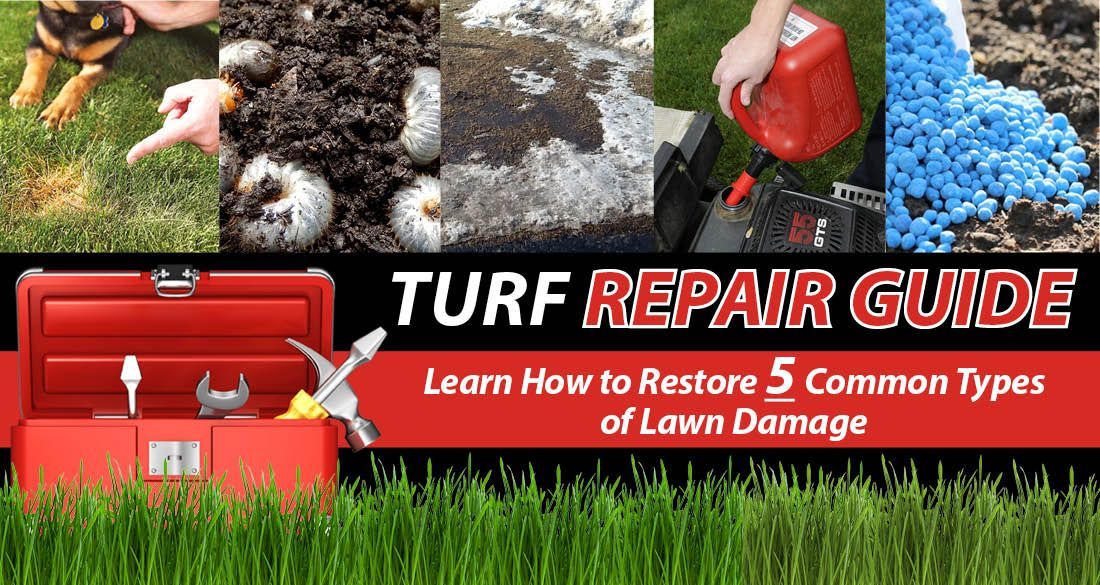
LEARN HOW TO RESTORE 5 COMMON TYPES OF LAWN DAMAGE
There’s nothing more frustrating than having a beautiful lawn ruined by a dead spot or divot. From fertilizer spills to mechanical damage, consider this feature your ‘pocket book’ guide to quick lawn repair. No messing around…let’s get your turf back in top shape!
1. FERTILIZER SPILL
It happens. Whether you’re filling up your spreader with a bag of granular fertilizer or filling your spray tank up with liquid, a fertilizer spill (especially those high in nitrogen) usually ends up leaving your turf with a dead patch. When fertilizer spills, nitrogen-containing salts draw water out of the soil as well as plant tissues, leaving turf to desiccate (dry out). Too much nitrogen also shifts the soil pH more acidic which creates a challenging growing environment. The good news is, if you act quickly, you might be able to save your turf from almost certain devastation.
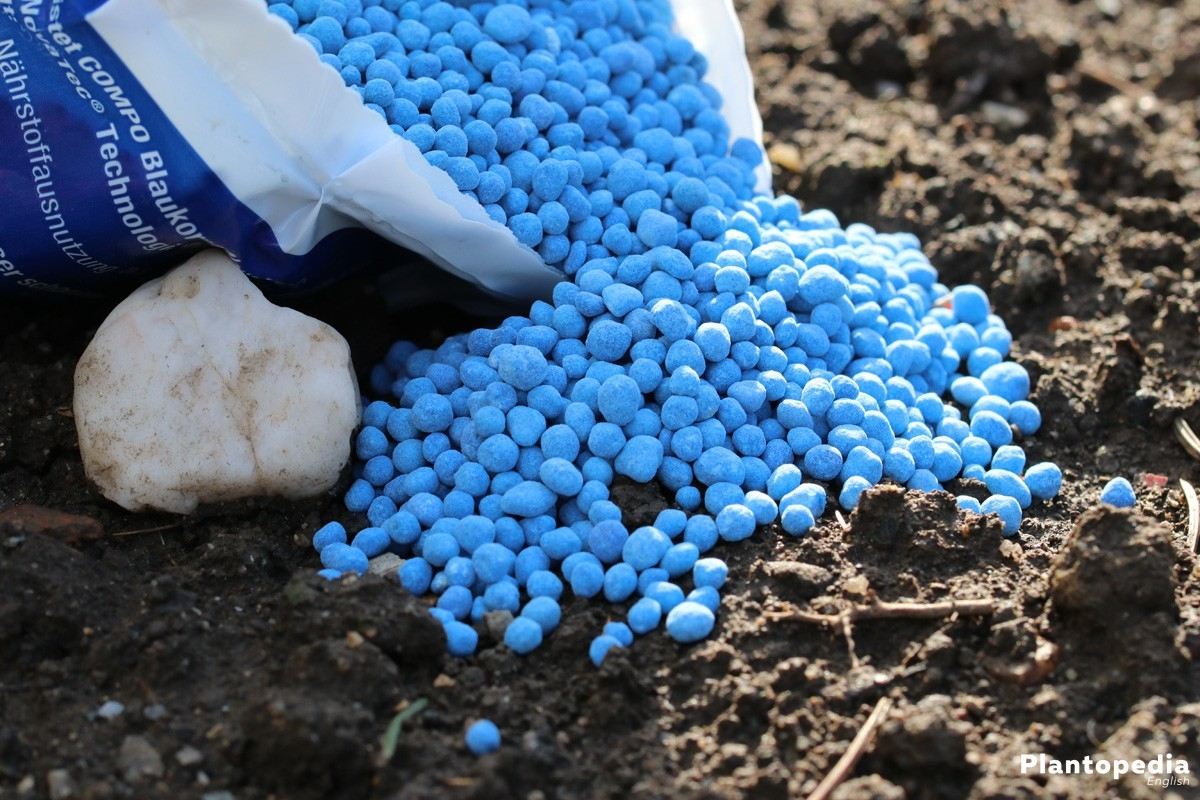
Fig. 1. Fertilizer Spill
In the event of a granular fertilizer spill…
- If practical, and depending on the severity of the spill, sweep the fertilizer granules up as best you can by any means (shovel, broom, vacuum, etc.)
- Immediately soak the spill area with water and dilute/distribute the fertilizer granules as much as possible. Continue to drench the surrounding area to distribute the fertilizer over as much surface area as possible.
- Continue to water the spill area and surroundings thoroughly over the next few days
Apply a modest dusting of lime over the primary spill area and a light dusting of lime over the surrounding area. Water in gently.
In the event of a liquid fertilizer spill…
- Immediately soak the spill area with water and dilute the fertilizer as much as possible.Continue to drench the surrounding area to distribute the fertilizer over as much surface area as possible.
- Continue to water the spill area and surroundings thoroughly over the next few days
- Apply a modest dusting of lime over the primary spill area and a light dusting of lime over the surrounding area. Water in gently.
In the event a fertilizer spill has already left a dead patch…
Use shovel to dig up the entire dead patch.Make sure to dig at least 4 inches down. Discard or compost the dead patch.
- Fill in the void with good quality top soil.
- Spread new grass seed across the topsoil surface.Gently work the seed into the soil with a dirt rake (about 0.5”-1” down). Tamp lightly. Cover with straw.
- Thoroughly water the seeds through the germination process. Continue to water once a day until the patch has filled in.
2. ANIMAL URINE
Fido may be ‘man’s best friend’, but he’s certainly not ‘lawns best friend!´ Dog and cat urine on the lawn is almost exactly like having a fertilizer spill. One of the largest components of animal urine is urea, the same exact urea from which most nitrogen fertilizers are made. Ideally, if you see your dog or cat urinating on the lawn, you should immediately treat it as a liquid fertilizer spill and dilute it with water to avoid ending up with a dead patch. With that said, we fully understand that most people aren’t going to do that. In the event you do end up with a dead spot and the culprit is animal urine, follow the steps in the previous example to repair your turf.
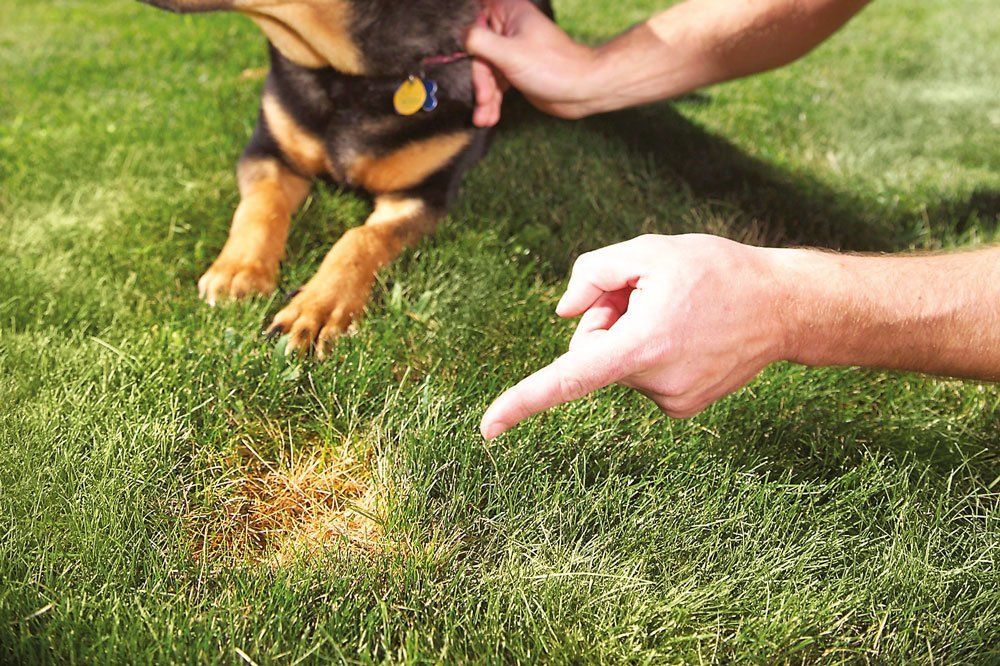
Fig. 2. Animal Damage to Lawn
3. SALT DAMAGE
Turf Care is headquartered in Brunswick, OH, a suburb of Cleveland. And if there’s one thing the midwest knows about, it’s salt damage. Ohio and many northern states are no stranger to receiving significant amounts of snow, and salt is the best way to keep the roads clear in the winter. Unfortunately, with the spring melt comes copious damage to tree lawns from salt accumulation. Road salt dries out plant tissues, leaving behind a mess of dead turf and stained soils. If your lawn is suffering from the effects of ice melt, try these steps:
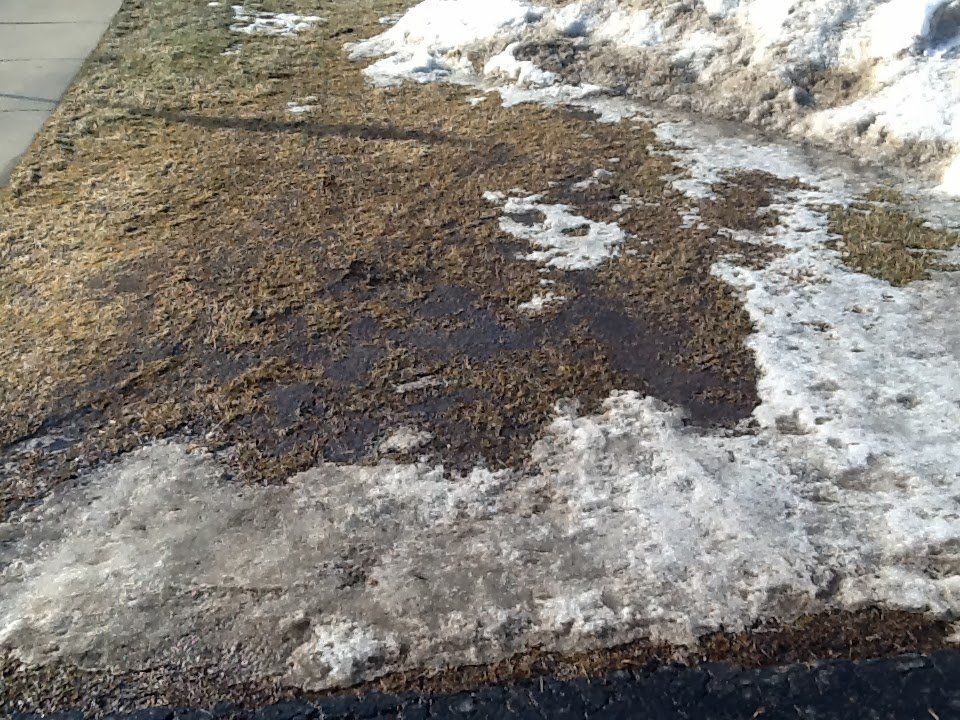
Fig. 3. Salt Damage to Lawn
- Apply pelletized gypsum to the affected area and water in gently. Gypsum will help reduce compaction as well flush out the excess road salt.
- Apply a thin layer of organic material to the affected area (top soil, potting soil, or humic acid all work).
- Cover the affected area with straw and thoroughly water for several weeks.
- Reseed if necessary (follow reseeding steps in first example).
4. MECHANICAL/PEST DAMAGE
Whether the dog was digging in the dirt or the kids tore up the turf playing soccer in the back yard, mechanical damage can be a visual eyesore. Mechanical damage can also come from burrowing creatures such as voles. These animals can do just as much damage as root feeding insects such as grubs. Before spending time and resources on turf repair, first make sure you have established the cause.
In the event of grub damage…
- As redundant as this sounds, make sure the cause really is grub damage. Root-feeding grubs and insects don’t always kill turf, but their underground presence can usually be verified by tugging gently upward on a patch of turf. If the turf easily comes up (like pulling a flat blanket straight upward off a bed), you probably have grub damage. If the turf doesn’t budge, something else may be the cause.
- Dethatch and aerate the target area as thorough as possible.
- Treat the affected area with a traditional insecticide (such as imidacloprid) or a bioinsecticide (such as nematodes).
- After an insecticide application, the grubs should begin to die in a few weeks
- Be careful not to over water recovering turf as excess water creates a friendly environment for feeding grubs.
- If dead patches develop, follow the ‘dead patch’ replacement procedure in the fertilizer spill section.
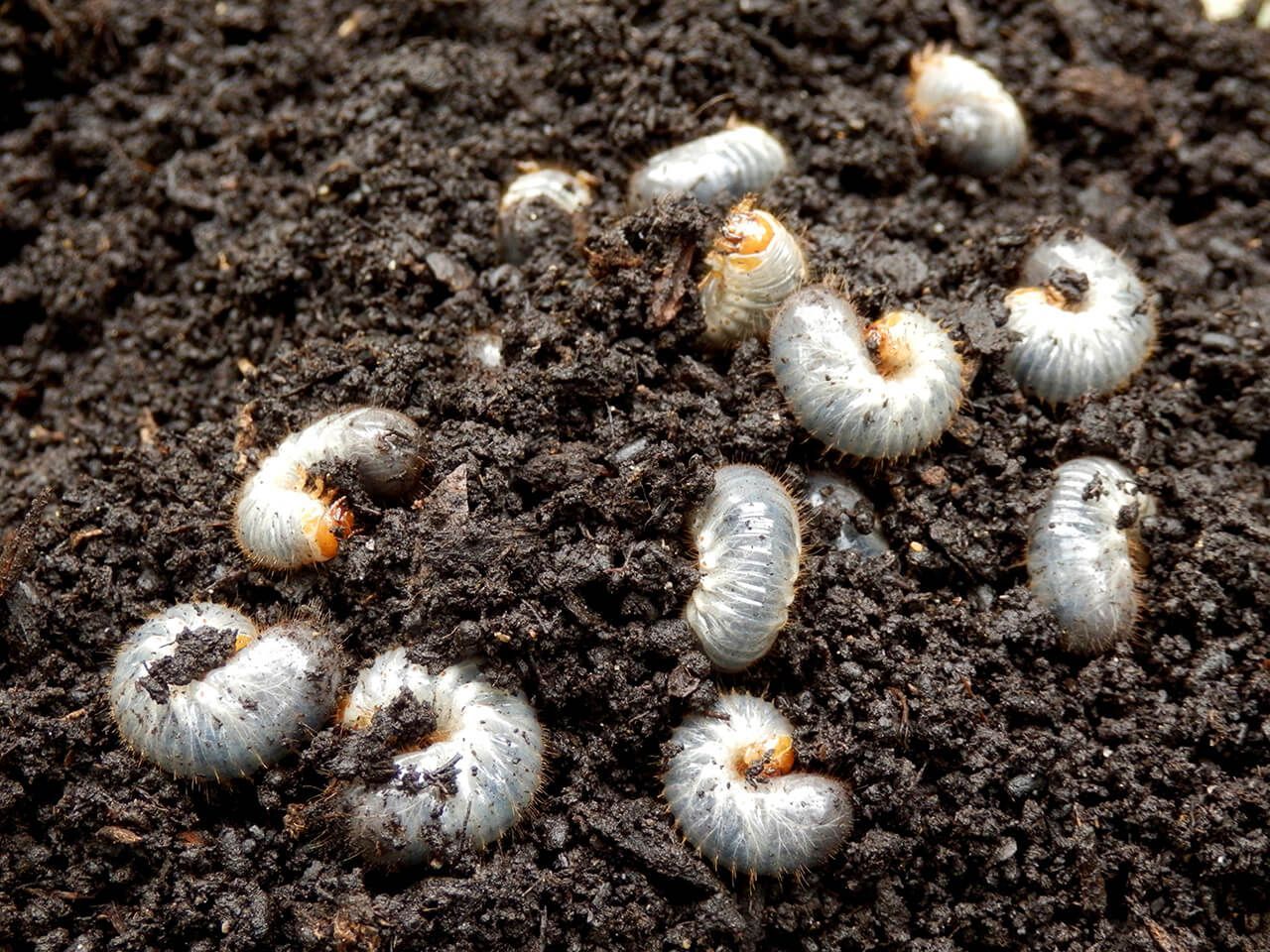
Fig. 4. Grubs in Soil
In the event of mole/vole damage…
- Place mole baits as deep as possible in the tunnel entrances. Use gloves and other protective gear when applying these baits as they are poisonous.
- Fill in any entrances and/or dirt mounds created by the moles.
- Use a castor-based mole repellent near the collapsed tunnel entrances. Water in thoroughly so that the castor oil penetrates the soil as much as possible.
- Use a yard roller to flatten your lawn in a effort to compress any additional tunnels that lie near the surface. Tip: soak the lawn in water first, as this will help make the soil more pliable.
- Moles can be difficult to eliminate; this process may take several weeks or months, and the above outlined steps may need to be repeated before being effective.
- If dead patches develop, follow the ‘dead patch’ replacement procedure in the fertilizer spill section.

Fig. 5. Vole Damage to Lawn
In the event of above ground mechanical damage from high foot traffic…
- High foot traffic is one of the most difficult problems to repair because it leads to severe compaction. Compaction can stress both root and shoot tissue and severely hinders water penetration and oxygen exchange.
- First, thoroughly aerate the compacted zone using a mechanical aerator. If the ground is very hard and virtually barren of turf, consider using a rototiller to turn over the soil. If tilling is necessary, use this opportunity to add organic material (such as a light layer of compost or humic acid) to the soil. Consider adding lime if a soil test warrants it.
- Spread new grass seed across the topsoil surface. Gently work the seed into the soil with a dirt rake (about 0.5”-1” down). Tamp lightly. Cover with straw. DO NOT LET PEOPLE WALK ON THE NEWLY SEEDED TURF.
- Thoroughly water the seeds through the germination process. Continue to water once a day until the patch has filled in.
- To give turf the best possible chance of surviving future high foot traffic, water turf thoroughly and aerate once or twice a year to reduce compaction.
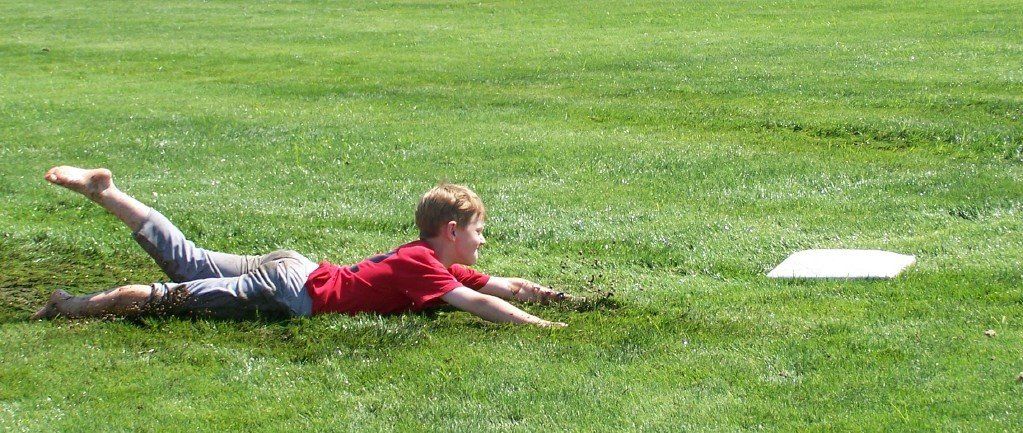
Fig. 6. Mechanical Damage from High Foot Traffic
5. GASOLINE/OIL SPILL
Again, it happens. You’re filling up your mower with gasoline or changing out the oil. Either way, the reservoir overflows and petroleum product ends up on the lawn. We all know what happens to turf when gas or oil hits the ground; a few days later you’re going to end up with a dead spot.
In the event of a small spill…
- Immediately break out the hose and attempt to dilute the spill as much as possible. Some species of soil bacteria can naturally breakdown hydrocarbons up to a certain concentration.
- Consider sprinkling activated charcoal across the soil surface as this material is extremely effective at soaking up hydrocarbons, heavy metals, and other toxic compounds.
In the event of a large spill (about 5 fl. oz or more)…
- Do not dilute the spill as this will only spread a significant problem over a larger area.
- Wait and observe. The affected turf will likely die within a few days.
- Once you are satisfied the dead patch perimeter has been established, grab a shovel and remove the entire dead patch as well as a few inches of healthy turf around the perimeter of the dead patch. Dig down at least 1 foot, as it is imperative to remove as much petroleum contamination as possible.
- Dispose of the dead patch in an environmentally appropriate manner.
- Fill in the void with fresh top soil. Add organic components (such as humic acid). Add lime if warranted by a soil test.
- Spread new grass seed across the topsoil surface.Gently work the seed into the soil with a dirt rake (about 0.5”-1” down). Tamp lightly. Cover with straw.
- Thoroughly water the seeds through the germination process. Continue to water once a day until the patch has filled in.
Bonus Tips!
- Remember, turf establishes best in the spring and fall months. In the event you need to reseed for whatever reason, consider reseeding in the spring or fall as this will greatly enhance the success rate of your newly establishing turf.
- Preventative lawn maintenance will reduce the chances of many of these common problems from occurring. The old cliché is true… the best defense is a good offense. Lawns that are adequately fertilized, watered, and aerated develop more robust root systems that are better to defend against abiotic and biotic stresses. Consider following a yearly turf maintenance plan or hiring a lawn care professional. Many state university ag extension offices post free maintenance calendars on their websites which are specialized for turf in your region and climate.
- If a pest problem doesn’t seem to be resolving itself, more aggressive strategies may need to be employed. Don’t hesitate to use the services of a licensed professional should more robust traps and pesticides be needed.
For professional fertilizers, humic and AMP-XC™ enriched products available, please visit TurfCare’s online Product Catalog.
For green industry professionals or others interested in ordering Turfcare products, please contact our Customer Service
to find a distributor near you.
Resources:
https://homeguides.sfgate.com/fix-dead-grass-fertilizer-50401.html
https://www.lawn-care-academy.com/lawn-dog-damage.html
https://www.thegrassmaster.com/how-to-avoid-salt-damage
https://homeguides.sfgate.com/treat-repair-moledamaged-lawn-75987.html
http://ag.umass.edu/turf/fact-sheets/current-insecticide-approaches-for-white-grub-control
http://www2.ca.uky.edu/agcomm/pubs/agr/agr55/agr55.pdf(Turf Maintenance Calendar – cool season grasses)
https://www.qbdfl.com/docs/manuals/YearlyCalendarFloratam.pdf(Turf Maintenance Calendar - warm season grasses)
Pictures:
Fertilizer Spill 01 https://www.plantopedia.com/wp-content/uploads/2017/05/blaukorn-n8.jpg
Digging Dead Dirt 02 https://www.blackanddecker.com/en-us/~/media/blackanddecker/images/ideas-and-inspiration/projects/repairing-bare-spots/repairing_bare_spots_10.jpg
Animal Urine Dead Spot 03 http://www.handyman.net.au/sites/default/files/g-lawns-late-autumn-yard-dog-spot-on-grass-MAIN.jpg
Ice Melt Damage 04 http://3.bp.blogspot.com/-cCwbehAHC58/UtgV_Vot3rI/AAAAAAAAAp8/Z8tmgN4A0gc/s1600/snow+14'+013.JPG
Mechanical Damage 05 http://ecomaids.ca/wp-content/uploads/2014/08/HowToRemoveGrassStains.jpg
Grubs in Soil 06 https://www.amdro.com/-/media/images/amdro-na/us/blog/getting-rid-of-lawn-grubs-hr/getting-rid-of-lawn-grubs-header.jpg
Vole Damage 07 https://themossytree.files.wordpress.com/2014/04/voledamage.jpg
Gasoline Spill 08 https://cleanairyardcare.ca/wp-content/uploads/2012/12/newgascan.jpg
Raking in Grass Seed 09 http://image1.gardenersworld.com/image.jpg?tag=caacd8d9-932b-4b8b-95da-c98201d5b620&width=1024&quality=80
The TURFReport Highlights:
Additional Articles and Insights

April 18, 2025
Turf Care Supply, LLC, a portfolio company of Platte River Equity, has officially acquired Beaty Fertilizer, the industry respected Tennessee-based manufacturer and blender of custom granular and liquid fertilizers, as well as combination products. This strategic move expands Turf Care’s manufacturing footprint, adds new product capabilities, and enhances overall production capacity.

October 4, 2024
Dear Valued Industry Partners and Customers, We are pleased to announce that Turf Care Supply, LLC has acquired Agri-Nutrients, Inc. (October 1, 2024) a respected manufacturer in the turf and ornamental fertilizer industry. This acquisition marks a significant step forward in our commitment to providing you with an expanded range of innovative products, services, and industry expertise, all designed to support your business’s continued growth and success. As a valued partner or customer, you will benefit from enhanced service capabilities and an extended geographic reach, thanks to Agri-Nutrients, Inc.’s strategic facility located in the Port of Catoosa, Oklahoma. With this established presence in the Southwest and Western markets, Turf Care Supply, LLC’s expanded operational footprint will allow us to serve a broader region with greater efficiency, delivering even stronger support to help drive your business forward. We are dedicated to ensuring a seamless transition while maintaining the high standards of service you expect. If you have any questions or would like to explore how this new location can enhance your operations, please feel free to contact your account manager or our customer service team. Thank you for your continued trust in Turf Care Supply, LLC . We look forward to partnering with you as we grow together and continue supporting your success. Sincerely, Mark ManganPresidentTurf Care Supply, LLC

September 28, 2023
With a focus on providing sustainable manufacturing and reducing carbon emissions, Turf Care Supply has embraced the electric power market with the latest mobile equipment upgrades. Completed in June 2023, TCS received all deliveries of electric forklifts to all three manufacturing facilities, including Hatfield, MA, Martins Ferry, OH and Sebring, FL.

July 19, 2023
When handling fertilizers and pesticide it is important to follow suggested guidelines and prioritize safety to protect yourself, others, and reduce environmental impact. Here are some general measures to follow: 1.Read and Follow Instructions: Carefully read and understand the product labels, safety data sheets (SDS), and any accompanying instructions provided by the manufacturer. Follow all recommended guidelines, precautions, and application rates.

June 22, 2023
It’s common knowledge that applying too much fertilizer containing high percentages of readily available nitrogen and water soluble nutrients can result in burn damage to plants, but did you know that damage can still occur even if your application rate is correct? Applying the right product at the right rate, but at the WRONG time can have disastrous consequences.

August 1, 2022
When summer temperatures rise and drought conditions set in, turf quality can suffer, even in healthy turf. Turf that was green and lush during the spring can be at risk for turning brown and going dormant during the summer months. This can lead to insect and weed infestations as well as other diseases that can result in additional turf damage. Being aware of these abiotic stresses can help lawn care operators, turf managers, and homeowners take steps to mitigate the damage from these stressors.

July 28, 2022
Brunswick, OH. (April 25, 2022) – Turf Care Supply, LLC (“Turf Care” or the “Company”), the leading formulator and blender of coated nitrogen and other fertilizer products to the turf & ornamental market, is excited to announce Michael Randall as the new Chief Financial Officer (CFO). Mike Randall has previously served as the CFO for both Anchor Manufacturing and for a private investment group, The Misfud Group, LLC. Mike has also held a variety of financial positions with Shiloh Industries in Valley City, Ohio and Eaton Corporation in Cleveland. Mike received his Accounting degree from Ohio Wesleyan University. “We are very excited to have Mike join the Turf Care team. Mike’s frontline leadership and successful C level experience make him an incredible addition to our company,” said Mark Mangan, President of Turf Care. Established in 1974, Turf Care Supply is one of the largest formulators and blenders of urea products to the turf & ornamental market. Turf Care has a comprehensive product portfolio of fertilizers, combination products (herbicide/insecticide), soil amendments and enhanced efficiency fertilizer ingredients. Turf Care's products are sold to distributors and blenders serving the commercial, residential and golf end markets.

April 18, 2025
Turf Care Supply, LLC, a portfolio company of Platte River Equity, has officially acquired Beaty Fertilizer, the industry respected Tennessee-based manufacturer and blender of custom granular and liquid fertilizers, as well as combination products. This strategic move expands Turf Care’s manufacturing footprint, adds new product capabilities, and enhances overall production capacity.

October 4, 2024
Dear Valued Industry Partners and Customers, We are pleased to announce that Turf Care Supply, LLC has acquired Agri-Nutrients, Inc. (October 1, 2024) a respected manufacturer in the turf and ornamental fertilizer industry. This acquisition marks a significant step forward in our commitment to providing you with an expanded range of innovative products, services, and industry expertise, all designed to support your business’s continued growth and success. As a valued partner or customer, you will benefit from enhanced service capabilities and an extended geographic reach, thanks to Agri-Nutrients, Inc.’s strategic facility located in the Port of Catoosa, Oklahoma. With this established presence in the Southwest and Western markets, Turf Care Supply, LLC’s expanded operational footprint will allow us to serve a broader region with greater efficiency, delivering even stronger support to help drive your business forward. We are dedicated to ensuring a seamless transition while maintaining the high standards of service you expect. If you have any questions or would like to explore how this new location can enhance your operations, please feel free to contact your account manager or our customer service team. Thank you for your continued trust in Turf Care Supply, LLC . We look forward to partnering with you as we grow together and continue supporting your success. Sincerely, Mark ManganPresidentTurf Care Supply, LLC

September 28, 2023
With a focus on providing sustainable manufacturing and reducing carbon emissions, Turf Care Supply has embraced the electric power market with the latest mobile equipment upgrades. Completed in June 2023, TCS received all deliveries of electric forklifts to all three manufacturing facilities, including Hatfield, MA, Martins Ferry, OH and Sebring, FL.

July 19, 2023
When handling fertilizers and pesticide it is important to follow suggested guidelines and prioritize safety to protect yourself, others, and reduce environmental impact. Here are some general measures to follow: 1.Read and Follow Instructions: Carefully read and understand the product labels, safety data sheets (SDS), and any accompanying instructions provided by the manufacturer. Follow all recommended guidelines, precautions, and application rates.

June 22, 2023
It’s common knowledge that applying too much fertilizer containing high percentages of readily available nitrogen and water soluble nutrients can result in burn damage to plants, but did you know that damage can still occur even if your application rate is correct? Applying the right product at the right rate, but at the WRONG time can have disastrous consequences.

August 1, 2022
When summer temperatures rise and drought conditions set in, turf quality can suffer, even in healthy turf. Turf that was green and lush during the spring can be at risk for turning brown and going dormant during the summer months. This can lead to insect and weed infestations as well as other diseases that can result in additional turf damage. Being aware of these abiotic stresses can help lawn care operators, turf managers, and homeowners take steps to mitigate the damage from these stressors.



